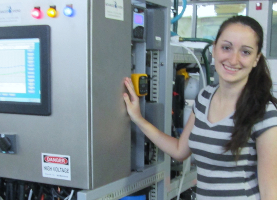
This last summer, I was fortunate to get an internship at the Bureau of Reclamation in Denver, Colorado. The Bureau of Reclamation is huge, so each intern gets put into a specific group and gets matched up with a mentor in their field. I was placed in the Water Treatment group, which is split into two sides: design and research. My internship has been more on the research side, where the Department of the Interior is focusing on desalination and membrane science for new water treatment processes. As you can imagine, desalination is basically taking the salt out of seawater to make it drinkable. Membranes help us to filter out particles like bacteria, colloids, and even viruses.
Many membranes systems are two-step: usually some kind of filtration to get bigger particles out (Ultrafiltration, Nanofiltration, etc.) and then either forward osmosis or reverse osmosis to remove smaller ions, such as salt ions. In forward osmosis, the water, called the solvent, moves from an area of low concentration through the membrane, to an area of high concentration. After the solvent is done moving through the membrane, both the right and the left side have equal concentrations of the solvent floating around in it. In reverse osmosis, we apply a pressure on one side to reverse the flow and push all of the solvent (water) to the other side. In the membrane, the raw water enters in to the membrane layers, which consist of the outer wrap, a spacer, the actual membrane, the collection material, and the central tube. We apply a pressure to the raw water to force it to move across the membrane layers into the product tube. As the water moves through the membrane layer, the salt and other unwanted items are rejected by the membrane and do not enter the product tube. The rejected salt (called the concentrate) then all exits together on the other end.
With the Bureau of Reclamation, my main project has been traveling this summer to Alamogordo, New Mexico to work in the Brackish Groundwater and National Desalination Research Facility (where I saw the world’s largest pistachio!). Here, we worked with a “smart” Ultrafiltration- Reverse Osmosis membrane system that can repair itself and stop itself from fouling. Fouling is the main problem with membranes and is the process where particles from the solute stick to the membrane surface and in its’ pores so that the membrane gets clogged. Our main project was to test the limits of this machine, and see how nasty of water we could put in before the membrane would start fouling. So far, we have tested blue-green algae, humic acid and sodium alginate.
I am so thankful for the opportunity that the Bureau has given me, and I have learned so much about Desalination and Water Treatment! Also, shout-out to the other CSU intern, James Waller, in the Materials Engineering: Soils Lab!